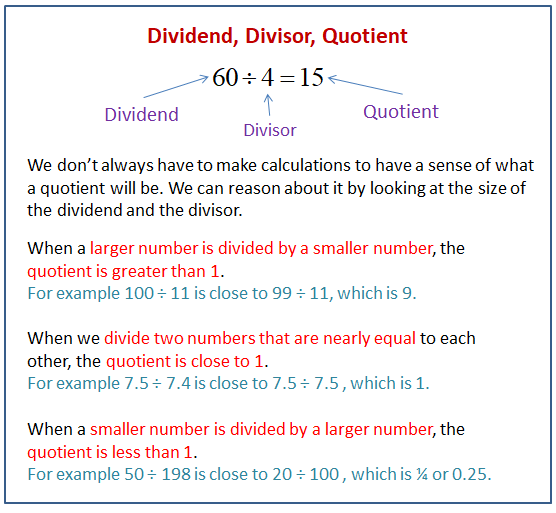Illustrative Mathematics Unit 6.4, Lesson 1: Size of Divisor and Size of Quotient
Learning Targets:
- When dividing, I know how the size of a divisor affects the quotient.
Related Pages
Illustrative Math
Grade 6
Lesson 1: Size of Divisor and Size of Quotient
Let’s explore quotients of different sizes.
Illustrative Math Unit 6.4, Lesson 1 (printable worksheets)
Lesson 1 Summary
The following diagram shows how to reason about the size of the quotient by looking at the size of the dividend and the divisor.

Lesson 1.1 Number Talk: Size of Dividend and Divisor
Find the value of each expression mentally.
5,000 ÷ 5
5,000 ÷ 2,500
5,000 ÷ 10,000
5,000 ÷ 500,000
Lesson 1.2 All Stacked Up
- Here are several types of objects. For each type of object, estimate how many are in a stack that is 5 feet high. Be prepared to explain your reasoning.
- A stack of books is 72 inches tall. Each book is 2 inches thick. Which expression tells us how many books are in the stack? Be prepared to explain your reasoning.
a. 72 · 2
b. 72 ÷ 2
c. 2 ÷ 72
d. 72 ÷ 2 - Another stack of books is 43 inches tall. Each book is ½-inch thick. Write an expression that represents the number of books in the stack.
Lesson 1.3 - All in Order
- Your teacher will give your group two sets of division expressions. Without computing, estimate their values and arrange each set of expressions in order, from largest to smallest. Be prepared to explain your reasoning. When finished, pause for a class discussion.
- Record the expressions in each set in order from largest to smallest.
Set 1
Set 2 - Without computing, estimate each quotient and arrange them in three groups: close to 0, close to 1, and much larger than 1. Be prepared to explain your reasoning.
30 ÷ ½
9 ÷ 10
18 ÷ 19
15,000 ÷ 1,500,000
30 ÷ 0.45
9 ÷ 10,000
18 ÷ 0.18
15,000 ÷ 14,500
Are you ready for more?
Write 10 expressions of the form 12 ÷ ? in a list ordered from least to greatest. Can you list expressions that have value near 1 without equaling 1? How close can you get to the value 1?
Lesson 1 Practice Problems
1.Order from smallest to largest:
- Number of pennies in a stack that is 1 ft high
- Number of books in a stack that is 1 ft high
- Number of dollar bills in a stack that is 1 ft high
- Number of slices of bread in a stack that is 1 ft high
- Use each of the numbers 4, 40, and 4000 once to make true statements.
a. The value of _____ ÷ 40.01 is close to 1
b. The value of _____ ÷ 40.01 is much less than 1.
c. The value of _____ ÷ 40.01 is much greater than 1. - Without computing, decide whether the value of each expression is much smaller than 1, close to 1, or much greater than 1.
a. 100 ÷ 1/1000
b. 50⅓ ÷ 50¼
c. 4.7 ÷ 5.2
d. 2 ÷ 7335
e. 2,000,001 ÷ 9
f. 0.002 ÷ 2000 - A rocking horse has a weight limit of 60 pounds.
a. What percentage of the weight limit is 33 pounds?
b. What percentage of the weight limit is 114 pounds?
c. What weight is 95% of the limit? - Compare using >, =, or <.
a. 0.7 ______ 0.70
b. 0.03 + 6/10 ______ 0.30 + 6/100
c. 0.9 ______ 0.12 - Diego has 90 songs on his playlist. How many songs are there for each genre?
a. 40% rock
b. 10% country
c. 30% hip-hop
d. The rest is electronica - A garden hose emits 9 quarts of water in 6 seconds. At this rate:
a. How long will it take the hose to emit 12 quarts?
b. How much water does the hose emit in 10 seconds?
The Open Up Resources math curriculum is free to download from the Open Up Resources website and is also available from Illustrative Mathematics.
Try out our new and fun Fraction Concoction Game.
Add and subtract fractions to make exciting fraction concoctions following a recipe. There are four levels of difficulty: Easy, medium, hard and insane. Practice the basics of fraction addition and subtraction or challenge yourself with the insane level.

We welcome your feedback, comments and questions about this site or page. Please submit your feedback or enquiries via our Feedback page.
